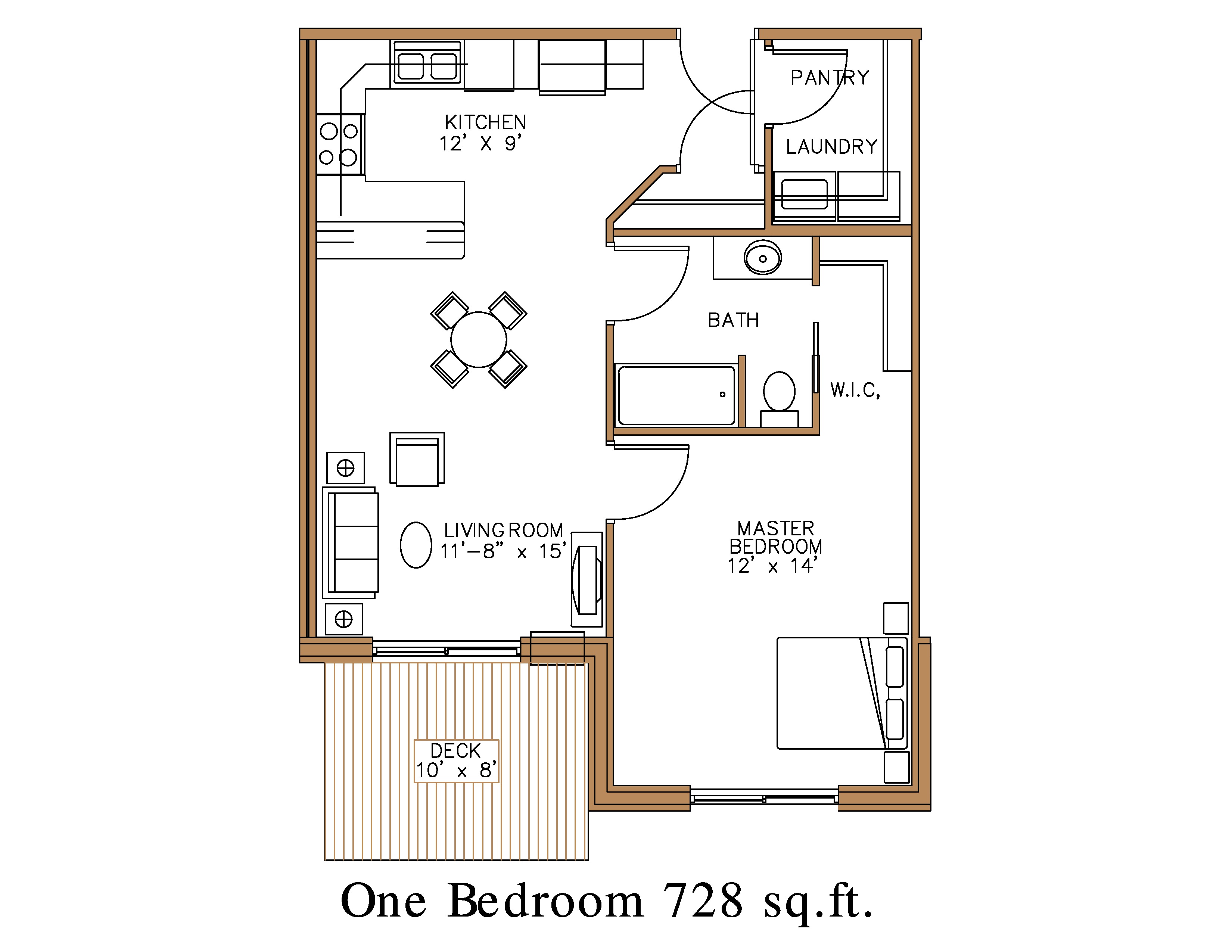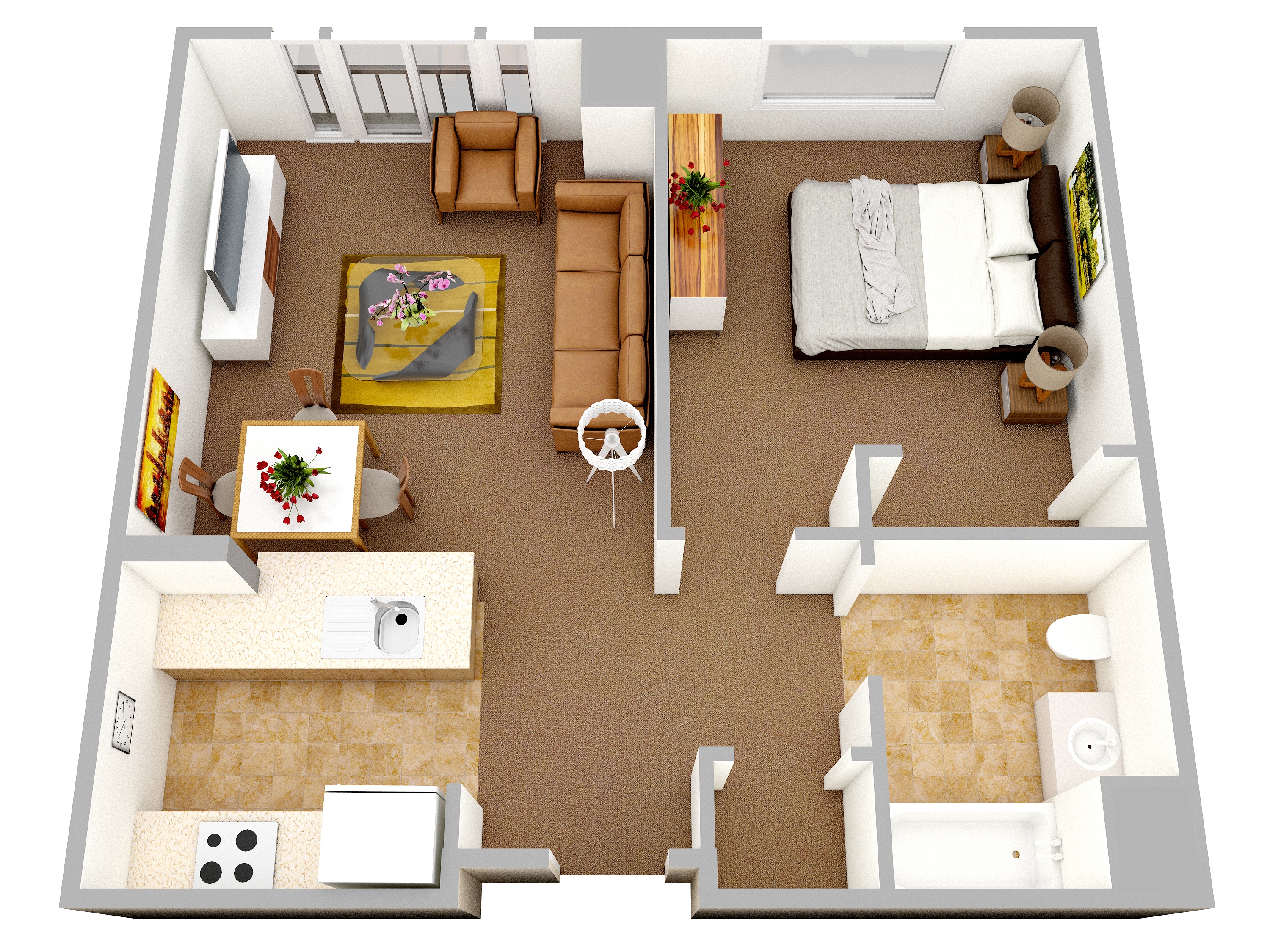Understanding One-Bedroom, One-Bathroom Floor Plans: One Bedroom One Bath Floor Plans

One-bedroom, one-bathroom floor plans are a popular choice for various demographics, offering a balance of space, functionality, and affordability. This layout is ideal for singles, couples, and even small families, catering to different lifestyles and needs.
Appeal of One-Bedroom, One-Bathroom Floor Plans
One-bedroom, one-bathroom floor plans appeal to diverse demographics due to their practical design and affordability. For singles, these plans provide a comfortable and independent living space without the burden of maintaining a larger home. Couples often find this layout suitable, offering a cozy and intimate environment. Small families, particularly those with young children, can also benefit from this layout, providing a manageable living space that’s easier to maintain.
Advantages and Disadvantages of One-Bedroom, One-Bathroom Floor Plans, One bedroom one bath floor plans
Advantages
- Space Efficiency: One-bedroom, one-bathroom floor plans maximize space utilization, offering a compact and functional layout that minimizes wasted area. This is particularly beneficial for smaller living spaces, maximizing the use of every square foot.
- Affordability: These floor plans generally require less construction material and are less expensive to build and maintain compared to larger homes. This affordability makes them an attractive option for budget-conscious individuals and families.
- Lower Utility Costs: The smaller living space translates to lower heating, cooling, and energy consumption, resulting in reduced utility bills.
- Ease of Maintenance: Maintaining a smaller home requires less time and effort, making it an ideal choice for individuals who prefer a low-maintenance lifestyle.
Disadvantages
- Limited Space: The limited space can be a challenge for larger families or those who require a lot of storage space. It may also limit the number of guests you can comfortably accommodate.
- Potential for Clutter: With less space, it’s crucial to maintain a well-organized and clutter-free environment to avoid feeling cramped. This may require careful planning and efficient storage solutions.
- Lack of Privacy: The smaller layout may limit privacy, especially for families with young children or guests staying over.
Examples of One-Bedroom, One-Bathroom Floor Plan Layouts
Open-Concept
Open-concept floor plans create a sense of spaciousness by eliminating walls between the living, dining, and kitchen areas. This layout maximizes natural light and creates a flowing and inviting atmosphere.
Traditional
Traditional floor plans offer a more formal and structured layout, with defined spaces for each room. This layout provides a sense of order and privacy, while still maintaining a comfortable and functional living space.
Modern
Modern floor plans emphasize clean lines, minimalist design, and open spaces. They often feature large windows, high ceilings, and a focus on functionality and efficiency.
Designing Efficient One-Bedroom, One-Bathroom Spaces
In the realm of compact living, optimizing space within a one-bedroom, one-bathroom layout is paramount. Every square foot counts, and strategic design choices can transform a small space into a haven of functionality and style.
Maximizing Space in a One-Bedroom, One-Bathroom Layout
Efficiently utilizing the limited space within a one-bedroom, one-bathroom apartment is crucial. By implementing clever furniture placement, incorporating multi-functional design elements, and embracing innovative storage solutions, you can create a comfortable and organized living environment.
- Furniture Placement: Consider multi-functional furniture pieces, such as a sofa bed or a dining table that doubles as a desk. Opt for furniture with built-in storage, such as ottomans with compartments or beds with drawers underneath.
- Storage Solutions: Utilize vertical space by installing shelves, floating cabinets, and wall-mounted organizers. Employ under-bed storage containers and maximize closet space with organizers and shoe racks.
- Multi-Functional Design Elements: Incorporate space-saving features like a Murphy bed that folds away during the day, creating a larger living area. Utilize a corner desk to maximize space and create a dedicated workspace.
Importance of Natural Light and Ventilation
Natural light and ventilation are essential for creating a comfortable and inviting atmosphere in any space, especially in smaller living areas. They contribute to a sense of openness, promote well-being, and enhance the overall aesthetic appeal of the space.
- Maximizing Natural Light: Utilize light-colored paint on walls and ceilings to reflect natural light. Install large windows to allow ample sunlight to flood the space. Consider using mirrors strategically to amplify natural light.
- Enhancing Ventilation: Install exhaust fans in the bathroom and kitchen to remove moisture and odors. Open windows whenever possible to allow fresh air to circulate. Consider using a ceiling fan to create air movement and promote ventilation.
Visual Representation of a One-Bedroom, One-Bathroom Floor Plan
Imagine a one-bedroom, one-bathroom floor plan with a rectangular layout. The bedroom is situated at the far end of the apartment, away from the entrance. The bathroom is conveniently located near the bedroom, providing privacy. The living area occupies the remaining space, with a spacious kitchen integrated into the open floor plan.
- Key Design Considerations: The living area features a sofa bed, a coffee table with storage, and a wall-mounted TV. The kitchen boasts a compact island with seating, providing a functional dining space. The bedroom includes a queen-sized bed with built-in drawers, a nightstand, and a large closet. The bathroom features a walk-in shower, a vanity with storage, and a toilet.
- Maximizing Functionality: This floor plan prioritizes functionality by utilizing every square foot effectively. The sofa bed serves as both seating and a sleeping space, while the kitchen island provides a multi-purpose area for dining and meal preparation. The bathroom is designed for efficient use, with a walk-in shower and ample storage.
Exploring Variations and Trends in One-Bedroom, One-Bathroom Floor Plans

The one-bedroom, one-bathroom floor plan, a mainstay in residential architecture, has undergone a remarkable evolution, reflecting changing lifestyles, technological advancements, and a growing emphasis on sustainability. This evolution is evident in the design trends, space utilization, and integration of technology in modern one-bedroom, one-bathroom homes.
The Evolution of One-Bedroom, One-Bathroom Floor Plans
The evolution of one-bedroom, one-bathroom floor plans can be traced back to the early 20th century, when the concept of the “compact home” emerged. These early designs prioritized functionality over spaciousness, focusing on efficient use of space and simple layouts. As time progressed, technological advancements and changing lifestyles influenced the design of one-bedroom, one-bathroom homes. The introduction of modern appliances, such as refrigerators and washing machines, led to a shift in the allocation of space within the kitchen and bathroom. The rise of the open-plan concept in the 1970s and 1980s further transformed the layout of one-bedroom homes, blurring the lines between the kitchen, dining, and living areas.
